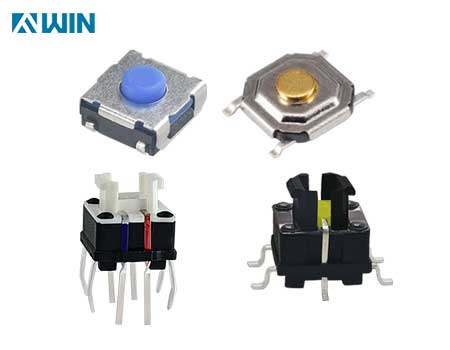KNOWLEDGE
What is the difference between push button and tactile switch?
Push buttons and tactile switches are two types of switches used in various electronic devices. Both are essential components used in different applications and perform the same function, i.e., providing an on-off signal to a circuit. However, they differ in their construction, behavior, and operation. This article discusses the key differences between push buttons and tactile switches.

Construction:
The most significant difference between push buttons and tactile switches is their construction. A push button switch has a simple design consisting of a push button cap, actuator, and a switch body with contacts. The button cap, made of plastic or metal, is attached to a spring, which is connected to the switch body. Pushing down the button compresses the spring, and the actuator makes contact with the switch body, completing the circuit.
On the other hand, a tactile switch, also known as a momentary switch, consists of a housing, contacts, and a metal dome. The top of the metal dome is typically exposed or covered with a thin layer of plastic. When pressed, the dome flattens, making a contact with the switch's fixed contacts. After releasing the pressure, the dome resumes its normal shape, breaking the contact.
Behavior:
Push buttons and tactile switches differ in their behavior as they operate in different ways. A push button switch operates in either a single-pole, single-throw (SPST) or a single-pole, double-throw (SPDT) configuration. When pressed, the switch completes the circuit, and when released, it opens the circuit, i.e., it has a latching mechanism. Push buttons are usually used in applications that require a permanent on-off signal, such as power switches, doorbells, and keypads.
Tactile switches, on the other hand, operate in a momentary contact mode, which means they provide a temporary on-off signal. The switch returns to its original position when released, which results in breaking the contact. Tactile switches are typically used in applications that require momentary contact, such as keyboards, game controllers, and remote controls.
Operation:
Push buttons and tactile switches differ in their operation as well. A push button switch requires more force to operate as it has a latching mechanism. The force required to push the button depends on the spring's stiffness and the switch's design. The button must be pressed until it clicks to ensure that the switch is engaged successfully. Push buttons are often used in applications where they need to withstand varying degrees of physical stress.
Tactile switches, on the other hand, require less force to operate as they are designed to provide momentary contact. The force required to actuate the switch typically ranges from a few grams to a few Newtons, depending on the switch's design. Tactile switches are often used in applications that require a delicate touch, such as in small electronic devices and keyboards.
Conclusion:
In conclusion, the significant differences between push buttons and tactile switches are in their construction, behavior, and operation. Push buttons are designed for latching-off and on the switch, while tactile switches offer momentary contact. Push buttons require more force to operate, while tactile switches require less force and provide a delicate touch. Both switches have unique characteristics and can be used in various applications. The choice of the switch depends on the application's requirements, such as durability, reliability, and ease of use.
Column navigation
NEWS
CONTACT ME
CONTACT:
Skype:evelynhwang2013
phone:15999819066
E-mail:fvwin@fvwin.com
ADD:NO.168,Technology East Road,Shijie Town,Dongguan,GD,CN